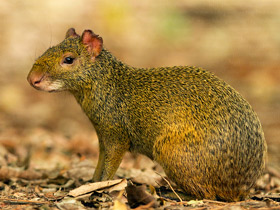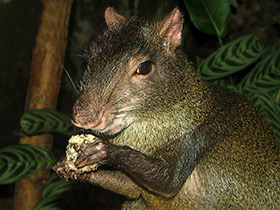The red-rumped agouti (Dasyprocta leporina), golden-rumped agouti, orange-rumped agouti or Brazilian agouti
The red-rumped agouti (Dasyprocta leporina), also known as the golden-rumped agouti, orange-rumped agouti or Brazilian agouti, is a species of agouti from the family Dasyproctidae.
Names
Despite the alternative name Brazilian agouti, it is neither the only nor the most widespread species of agouti in Brazil. In Brazil all agoutis are often called "cutia" [kuˈtʃiɐ].
Description
Dasyprocta leporina has a slender body, with long and slender limbs adapted for running. The fore and hind limbs have 3 toes each, the toes of the hind limb with strong hooked claws. The hair cover is rather sparse and coarse, the longest hairs being on the sacrum. The body length of Dasyprocta leporina varies from 48 to 63 cm and its weight from 3 to 6 kg. This animal has coarse hair, noticeably longer on the back. The upper body colour is olive-grey, the cheeks are rarely covered with hair. The colouration of the hind back is red-yellow. There are a few vibrissae at the periphery of the muzzle and above the eyes. The ears are prominent, rounded, covered inside and above with short, uniformly dark hairs. The legs are darker coloured than the body. The front legs have four very short toes. The hind feet have three toes, the middle of which is long. The bare soles are markedly elongated. The tail is very short and glabrous.
Habitat of Dasyprocta leporina
Dasyprocta leporina is distributed in the tropical forests of South America; it occurs north of the Amazon and east of the Rio Negro in the following countries: Brazil, Guiana, Guyana, Suriname, Trinidad and Tobago, Venezuela; it has been introduced to the Lesser Antilles. Its typical habitats are dense tropical forests in the Amazonian jungle along the banks of rivers; in the mountains it rises up to 2000 m above sea level. It also occurs in riverine savannahs, sometimes penetrating into developed areas.
Social behaviour
Dasyprocta leporina lives in pairs, which persist until the death of one of the partners. It is territorial, the area of a family plot is 1-2 ha. The male is quite active in defending the boundaries of its territory from invasion of strangers. This rodent makes its burrows between stones on the banks of rivers or under the roots of trees. In addition to burrows, the agouti has several resting places on its territory, located in empty fallen trunks, among tree roots. The shelters are connected by well-marked trampled paths.
Life style
Dasyprocta leporina is well adapted to moving on the ground: it walks, runs at a trot and gallop, leaning only on its toes, and can jump up to 2 m in height. In case of danger, it most often lurks in the thick vegetation and raises its front paw like a setter. When feeding, the agouti sits upright on its hind legs, holding food in its front legs.
Breeding
Mating behaviour in Dasyprocta leporina is accompanied by ferocious fights between males, sometimes resulting in injury to the opponents. Usually a female brings one, rarely two broods of 1-2, rarely 3 cubs per year. Young can be seen in any month, but they are especially numerous during the fruit ripening season, i.e. from March to July. Reproduction and numbers of Dasyprocta leporina depend very much on fruit tree yields. These animals live in pairs or family groups consisting of parents and young. The gestation period of Dasyprocta leporina lasts from 104 to 120 days. The female gives birth to one to three cubs and feeds them with milk for about 20 weeks. The life expectancy of these animals in captivity is 15-20 years.
What Dasyprocta leporina feeds on
Dasyprocta leporina eats mainly fruits, to a lesser extent - green vegetation, shoots and tubers. Having eaten fruits, the rodent buries their seeds in the ground as a reserve. Quite often agouti follows herds of monkeys travelling in the upper tier and picks up fruits dropped by them. Sometimes it catches and eats freshwater crabs and other aquatic invertebrates.
Dasyprocta leporina is often the prey of local inhabitants. Even before the arrival of Europeans in South America, Indians acclimatised agouti on the islands of the West Indies to replenish their meat supply. There, these rodents have survived in small numbers to this day.

















































